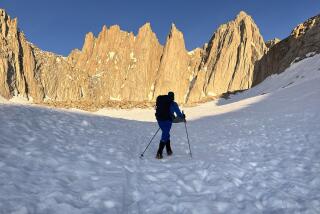‘The Boys of Everest,’ chronicled at their peak
CAPE ELIZABETH, MAINE — Clint Willis dreamed of pursuing the kind of extreme mountaineering pioneered by a ragtag band of climbers, most of them British, who brought their sport to a new level in the three decades following the conquest of Mt. Everest.
To help reconcile those unfulfilled yearnings, he detailed the astonishing accomplishments and heart-rending losses of Chris Bonington and his circle of climbers whose high-altitude expeditions in the Alps and the Himalayas have become the stuff of legends.
Willis’ new book, “The Boys of Everest: Chris Bonington and the Tragedy of Climbing’s Greatest Generation,” whisks armchair adventurers onto such climbing challenges as the Eiger in Switzerland, Mt. Annapurna in Nepal, the K2 in Pakistan and on the Nepal-Tibet border, Everest, where climbers battling treacherous rock faces and unforgiving weather met glory and doom.
Bonington survived those expeditions and went on to win a knighthood in 1996. But roughly half the climbers associated with him perished over the years as they stretched themselves to their limits and beyond.
“Part of the reason I wrote this book was to work through my own sense of not having taken certain chances, done certain things, that I was on one level drawn to do,” said Willis, a longtime rock climber. “At the same time, these guys paid such a high price for their climbing that there’s some wisdom in finding alternative ways to find meaning in your life.”
After Edmund Hillary and Sherpa Tenzing Norgay became the first climbers to successfully reach Everest’s summit in 1953, some people were left wondering whether there was anything for mountaineers to achieve after the planet’s tallest peak had been conquered.
Bonington and the dozen or so climbers who became known as Bonington’s Boys answered that question by gradually jettisoning the siege-like tactics of Hillary’s generation, an Oxbridge-educated group that employed armies of porters and used tons of equipment and thousands of feet of fixed rope.
The new breed of climbers, drawn largely from the working class, looked for newer, more difficult routes that had never been scaled or attempted. Climbers ventured out in small teams that could travel lighter and faster, sometimes without supplemental oxygen.
As they knocked off such first-ever achievements as a direct route up the Eiger’s North Face, Annapurna’s South Face and the Southwest Face of Everest, Bonington and his companions became household names in Britain. It was a different story in the United States, where Bonington remained largely unknown to the general public, his achievements followed only by climbers and others caught up in the sport.
Willis, however, was captivated early on. The 49-year-old New Orleans native acquired his lifelong love of rock climbing at age 10 in the mountains of North Carolina. By the time he was 15, he had immersed himself in Bonington’s writings and dreamed of following a similar path.
More to Read
Sign up for our Book Club newsletter
Get the latest news, events and more from the Los Angeles Times Book Club, and help us get L.A. reading and talking.
You may occasionally receive promotional content from the Los Angeles Times.








